ReFeRe
Museum
of Imaginary Worlds – Alter Ego Workshop: the ReFeRe
 home
home
The Oasis, alias the Double
Eight, alias Alcatraz
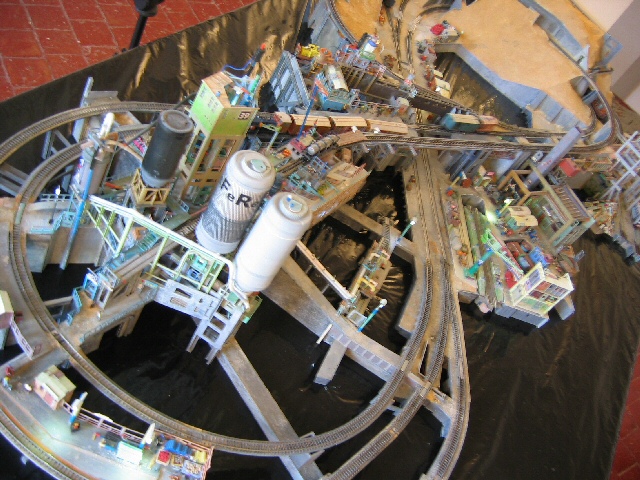
A double track describes a figure eight, an
unusual geometric form imposed by the principle of strepsidromie. You
won't find this word in your dictionary; it is
a neologism, coined especially for ReFeRe from two Greek roots, drome,
a path or road and strepsi, twisted. It serves, by means of
a branch line, some remarkable installations. It
is here that two very important commodities are produced: the special
adhesive
that binds all of ReFe Re together and the food that fuels its
workforce. Here too the purpose-built vehicles are
maintained and the workforce fed. Work
is the sole aim, and noise and smells are part of the scenery. And of
course, as
is the case throughout the ReFeRe, everything travels by train.
The ‘Collerie’
is an industrial complex for producing and
processing the special adhesive; and it is situated in one of the
curves of the
Double Eight on the Oasis. It has nothing to do with the English word
colliery.
Collerie is another neologism; Alain is as prolific as Shakespeare or
Lewis Carroll in his coinings. Coller
is to stick or adhere; and this amazing material is never riveted,
screwed,
soldered or attached with double sided sticky tape: it is always stuck,
it has
to be stuck, and it stays stuck. Hence the name. Shall we call this
complex The
Adhesion Centre? It includes offices and laboratories,
reactors and silos,
walkways and conduits, platforms and warehouses, all under the watchful
eye of
the green tower, otherwise known as the Pentagon. From the technicians
down to
the labourers, all the workers soon get sticky themselves; their
workmates say
they bring bad luck and have nicknamed them the Sticky Squad.
As for the Petite Chimie – let's call it
the minilab – you will soon realise
that this is an installation designated 'extremely hazardous'. You will
find it
along a dead end on the edge of the island site. You would be wise not
to ask
what they make there, and still wiser to refrain from inhaling anything
even
from a distance.
Near the crossing (on two levels), in front
of the closed power station, is a kind of platform cut out of a
vestigial
canal. This is the Havre des Glisseurs
– let's call it the hovercraft harbour. These devices stop here when
they are
not passing from one island to another in the archipelagic empire of
ReFeRe,
carrying an entire train on an invisible cushion of connective tissue
and
compressed air on the hovercraft principle. Old railway trucks act as
studies
and tool stores.
At the foot of the yellowish mountain –
made up of a mixture of débris and detritus – is the Mine.
This vast underground vault is reached by rail through a
series of tunnels. Facing the platform at the bottom are underground
installations.
The most important of these, and of paramount interest to the
workforce, is the
kitchen. Here is concocted the famous (or infamous) railwaymen's soup.
All the
engine drivers stop here on even the flimsiest of pretexts in the hope
of
scrounging some. However, thanks to a special convoy, the Mobile
Canteen,
supplies of food are delivered to everyone's workplace throughout the
site.
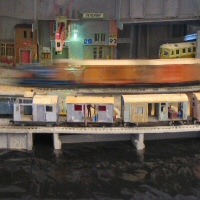 |
On the shiny curved
rails two trains speed along in opposite directions, eating up the
miles (well,
the centimetres) in a series of crosscrossings and near-misses. But all
this
frantic activity gets them nowhere. Never mind. Think of the pleasure
of
watching your electric train set, add plenty of ramifications and
twists – and
enjoy! |
The Nuclear Power Plant
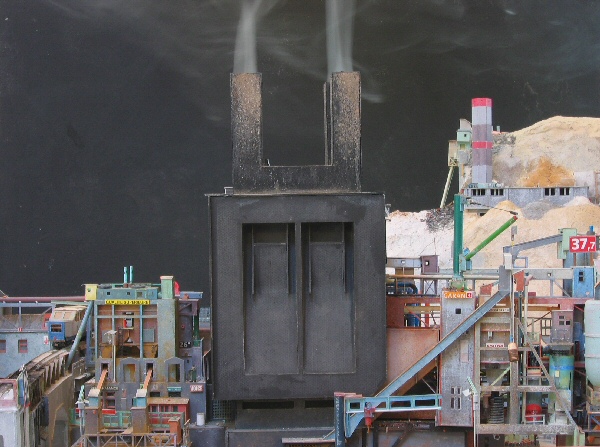
This is the most sensitive area, only
recently unveiled. It provides the electric power necessary for the
smooth
functioning of the ReFeRe. The fact that the electric cables are
invisible is
an ecological and aesthetic goodwill gesture which nevertheless cannot
gloss
over the extremely problematic, polemical – nay, machiavellian – nature
of
everything that happens within this amazing complex. The mere
word 'nuclear' has had its uses; it
has inspired fear and respect and attracted generous grants towards the
cost of
dismantling the plant – a simple matter because no plutonium has ever
been
involved here. Instead, under the guise of nuclear processing, fruit
pips and
stones were possibly consumed in
boilers. Wagons can be observed going in loaded with garbage of all
kind,
especially the most noxious, and coming out with oil drums – probably
full of
concentrated waste to sell abroad.
The
Gridiron is a classic arrangement of parallel
tracks where wagons are parked for loading or unloading. There are no
points as
such at either end. Instead sector plates are used, designed for trains
with
just one wagon: a unique arrangement, and very space-saving. The
winding track
– also a one-off – serves various installations both active and
disused.
Historically, its route has undergone some radical modifications,
notably to
overcome the unreliability of the Lift, which is currently
stuck on the
first floor.
The
Brewery got its name from its 19th century
Central European appearance, but nothing as harmless as beer is
produced there.
This harmless-looking rectangular grey building harbours chemical
installations
which are definitely not fit to be seen. Beyond an intermediate
building is a
heavy duty mixer/crusher. This device, and others like it, are at the
heart of
the 'cost-effective development' of the VAC (Very Advanced Chemistry)
of
ReFeRe. Processing involves pounding waste, crushing it, grinding it,
distributing it to all four corners of the site, transporting, mixing,
pulverising and compacting it and generally rendering it completely
unrecognisable.
The
Very Tall Blast Furnace (VTBF for short)
is a towering black structure crowned by four chimneys, one at each
corner,
from which smoke billows from time to time, giving off strange stenches
redolent of entrails glowing red or phosphorescing palely. We can know
nothing
about the metabolic process at work
here, and even less about what is going on underneath.
The
Refinery is a storage facility which guarantees an
ample supply of combustible material for the VTBS. Its reactors,
reservoirs
and silos, which are linked together by
walkways and conveyor belts and connected by brightly coloured
pipework. Here
too the role and function both of the parts and of the whole defy
description.
In any case noxious and obnoxious gases escape; and the little workshop
at the
foot of the mountain (yet another recycled railway truck) is fitted
with a red
schnorkel. The Refinery is staffed entirely by volunteers.
The
Soft Mountain dominates the whole island as if it
would like to swallow it up (which it will indeed do, one day). It is a
giant
spoil heap: layer upon layer of waste discharged, by means of temporary
railway
lines later dismantled, lift shafts that have been filled in, and no
doubt
green recycled cranes. The mountain waits patiently for the time when
future
generations, their studies funded by scholarships, will develop the
technology
to make use of it. The orogenesis – the quasi-geological evolution - of
this
mountain will have swallowed up at least one beautiful building, whose
walls
are still visible.
At the other end of the Gridiron, the
mighty Cruncher has broken down. A drum on its way
to be recycled has
landed askew on the conveyor belt and
fouled up the works. Close by is the landing stage which looks out onto
the
immensity of the Stroma, which
resembles an infinite morass of waste.
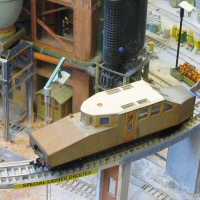
|
All is quiet on the
Gridiron. Work continues as usual, away
from prying eyes. Meanwhile, tirelessly but not always regularly, the railcar,
nicknamed Le Cafard. In French, un cafard has several meanings: a
cockroach, 'the blues' and a sneak - someone who spies on his comrades and
informs them. The Sneakmobile comes and goes along the sinuous single track. It
does not collect or deliver anything – its sole function is surveillance.
|
ASAF –
Académie des Sciences et
des Arts Ferroviaires
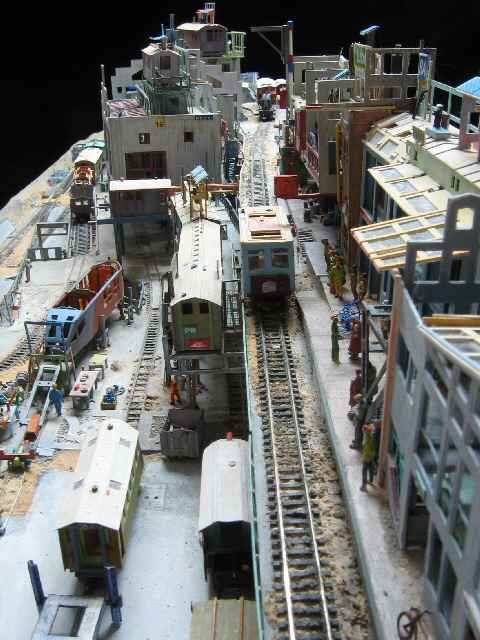
The distinguishing feature of this island
display is its historical interest - it is the earliest – together with
its
rectangular layout, the inventiveness of the turntable and the grand
scale of
the premises of the Académie des Sciences et Arts Ferroviaires (ASAF) –
the Academy of Railway Arts and Sciences.
The
Turntable with its three main railway tracks
enables entire trains to be turned around or shunted into sidings at
will. Its
originality, its ambitious technology and its sheer geometric
beauty were the inspiration for the ReFeRe logo. The
alignment and the contacts with the
fixed rails are entrusted – with tremendous daring – to swivelling
gantries,
the only ones of their kind in the world of railways.
The
Experimental Recycling Facility, a mine from which
nothing is extracted, is a cutting-edge laboratory, the scene of
tireless
research into methods of disposing of the precise blend of cement,
asbestos and
other secret ingredients from which everything here is
constructed.
The ASAF premises, behind
their elegantly carved pediments, house the deputy heads as well as the
designers, the engineers, the teachers, the communicaters and their
pupils,
disciples, apprentices and trainees as well as various sycophants and
hangers-on. Because of shortage of space they have built a
'wagonville', a
shanty town overhanging the adjoining tracks. This shanty town of old
trucks
minus their wheels is used for storage.
In the courtyard, workmen are busying themselves with constructing a
prototype AGV (Autorail Grande Vitesse – high speed railcar) while a
small team
of specialists concentrates on testing prototype seating.
The Station, at the top,
is a mere halt with a platform where prospective passengers wait
patiently for
a train.
The Landing Stage, at the
bottom, is served by a sloping branch line, whence the trains bound for
other
islands of the Archipelago are transported by a 'glider', which seems
to remble
a hovercraft.
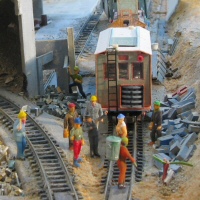 |
But
nothing is moving on any of the three tracks;
everything is at a standstill. A train carrying waste materials
(consisting of
a shunter and three special trucks), has had to make an emergency stop
in front
of a man in orange overalls with a dustbin on his shoulder. There he
stands,
planted squarely between the two rails, making it clear that he intends
to
empty his rubbish into the truck.
The driver of the train refuses point blank, arguing that
he is conveying a consignment of waste, that he is not a dustman and
that he
does not pick up garbage. This dispute could run and run...
|
Rosemary
Border
summer
2011- MMI/AEE at Sauvigny
home
page
 home
home




